Performance reviews are an essential part of a healthy and productive workplace.
Unfortunately, the review period can cause significant stress and anxiety to both employees and those reviewing their performance.
Employees are afraid of poor results, while managers are faced with juggling multiple performance reviews and reporting the evaluation process results to higher management.
But, what if we told you there’s a way to make your next employee evaluation process less stressful for everyone involved while ensuring consistency?
Performance review templates can provide much-needed guidance and make sure your review process runs smoothly.
In this blog post, we’ll provide you with 12 free performance review templates and answer some questions about why and how to conduct successful performance reviews.

What is a performance review template?
A performance review template is a document or form organizations use to evaluate an employee’s performance. It usually has predefined sections for questions and prompts that cover various aspects of an employee’s job performance.
For example, your basic employee review template may go over the employee’s:
- Job responsibilities,
- Goals for the future,
- Strengths,
- Areas for improvement, and
- Overall performance ratings.
On top of that, performance review templates can also include spaces for:
- Comments, and
- Constructive feedback.
Using performance review templates saves time and ensures fairness and consistency in assessments.
However, the key to successful employee evaluation is establishing a communication-first culture in the workplace. So, set yourself up for success by choosing an employee communication app that fully supports your communication needs.
In that regard, Pumble is the perfect option for your team, allowing you to share important documents and communicate throughout the review process over public and private channels, video calls, and more.
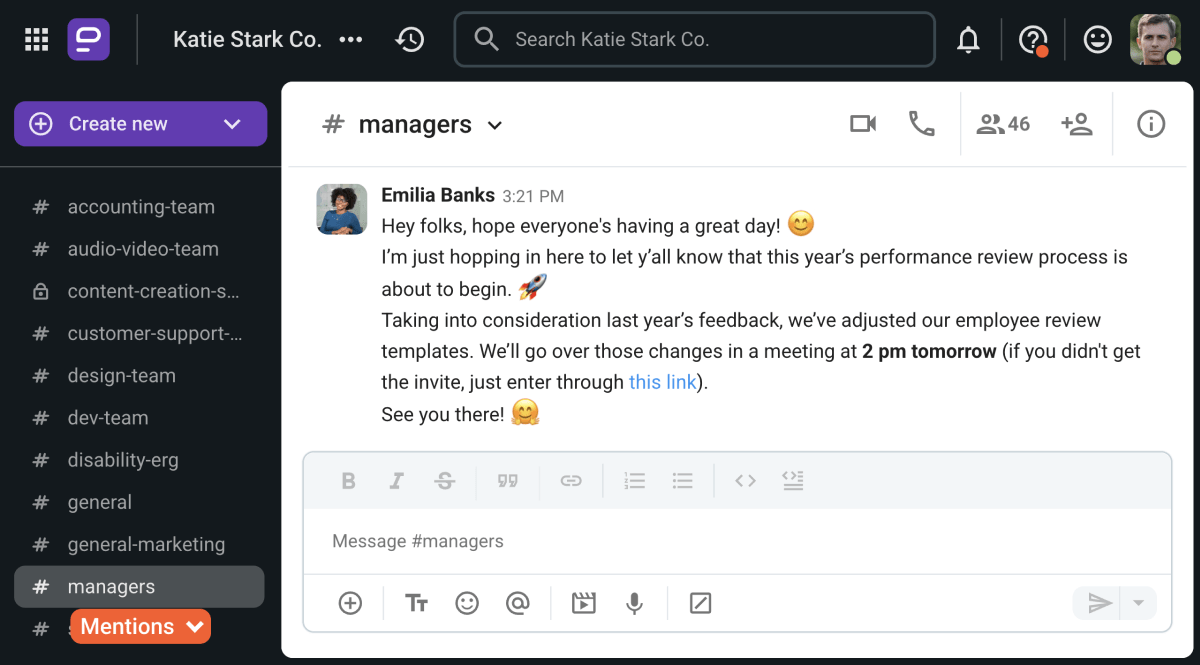
🎓 PUMBLE PRO TIP
If you want to learn more about performance reviews, why they are important, and how to conduct them, follow the link below to read our blog post:
Performance review templates
We’ve prepared 12 templates that you can download right away for free and then edit according to your specific needs.
Let’s get right into performance review templates!
Annual performance review template
Annual performance reviews are used in many industries and organizations, covering job performance over a year.
As such, they’re usually geared toward discussing overarching goals, achievements, and challenges rather than producing a detailed analysis of an employee’s performance.
The annual performance review template we’ve prepared covers the following categories:
- Job knowledge,
- Quality of work,
- Communication skills,
- Teamwork,
- Initiative, and
- Overall performance.
You can download the annual performance review template pictured below as an editable document or as a print-friendly PDF file.
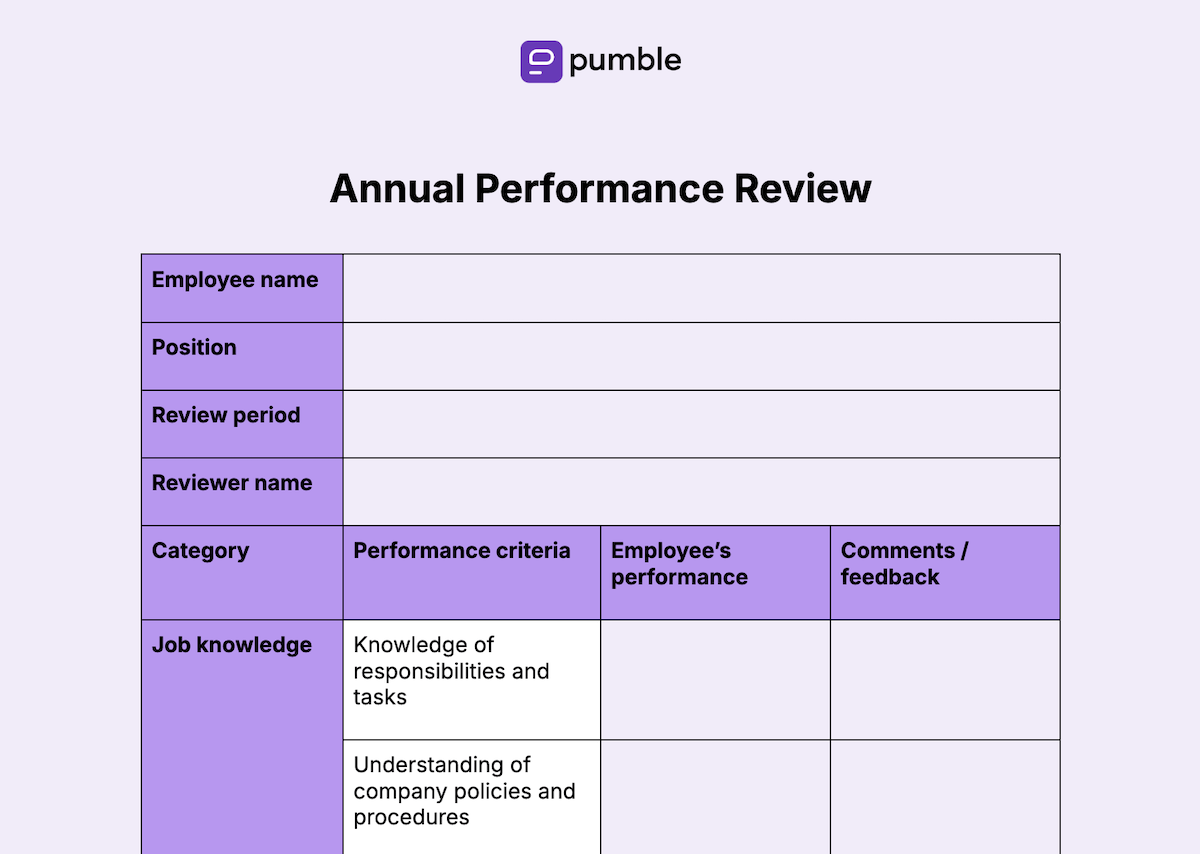
🔽 Download the Annual performance review template
🔽 Download the printable Annual performance review template
Quarterly performance review template
A quarterly performance review is held every 3 months at the end of each quarter.
Quarterly performance reviews allow for more frequent feedback than annual reviews but are less overbearing than monthly reviews. A 3-month review allows for enough time to review performance on a larger scale without waiting a whole year to assess an employee.
Our quarterly performance review template covers the following categories:
- Progress of goals,
- Quality of work,
- Communication skills,
- Team collaboration,
- Challenges faced,
- Strengths,
- Areas for improvement, and
- Overall performance.
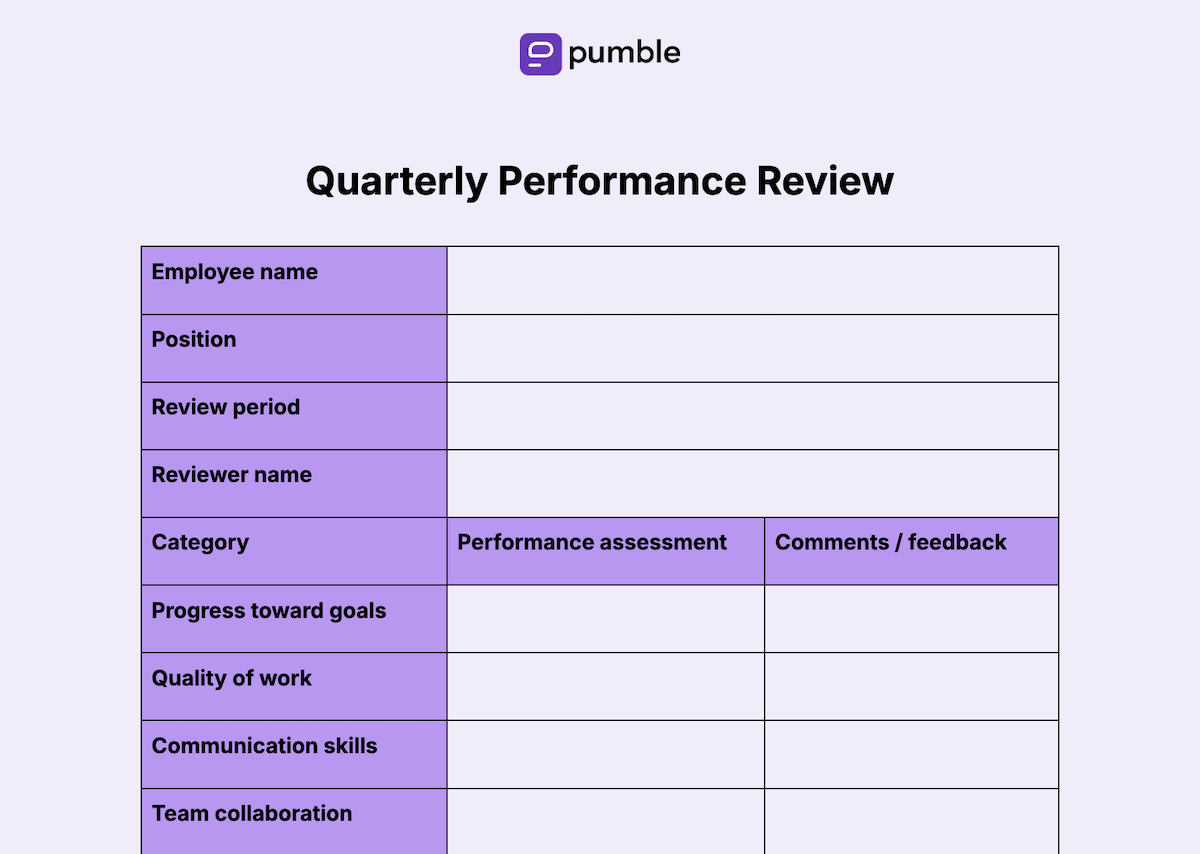
🔽 Download the Quarterly performance review template
🔽 Download the printable Quarterly performance review template
Monthly performance review template
Unlike annual or quarterly reviews, monthly reviews offer more frequent opportunities to discuss employees’:
- Professional goals,
- Recent achievements,
- Areas for improvement, and
- Challenges of the job.
Monthly reviews are a good in-between solution to weekly or quarterly evaluations.
During monthly reviews, you can do a descriptive performance assessment or rely on a numerical rating system.
You can use our performance review template to conduct both of these styles of assessment. You can use the “performance review” fields to add either numerical ratings or descriptions of the employee’s performance.
Even if you stick with numbers, the “comments and feedback” sections will allow you to add any further thoughts you might have about different categories of performance.
Speaking of which, our monthly performance review template covers the following categories:
- Progress of goals,
- Completed tasks,
- Quality of work,
- Communication skills,
- Team collaboration,
- Challenges faced,
- Strengths,
- Areas for improvement, and
- Overall performance.
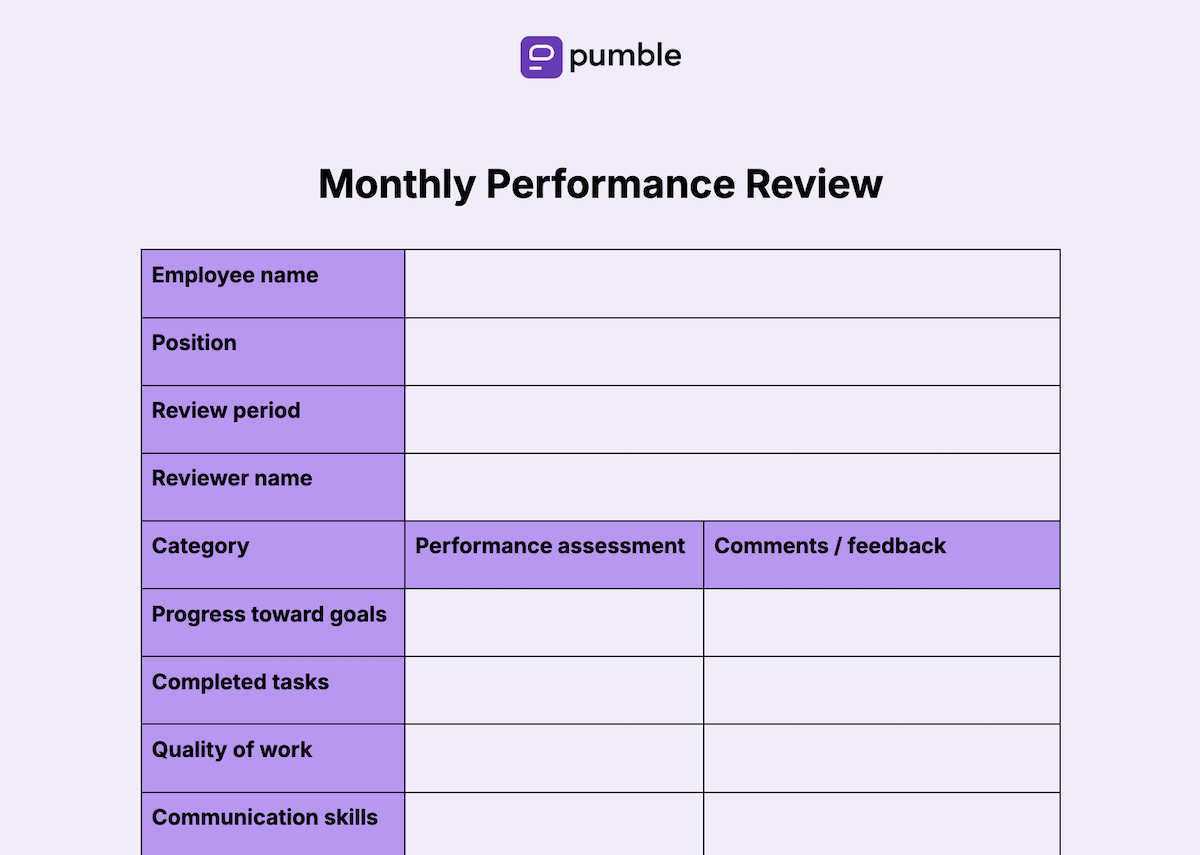
🔽 Download the Monthly performance review template
🔽 Download the printable Monthly performance review template
Weekly performance review template
Weekly performance reviews provide more immediate feedback and allow for ongoing mentoring and adjustment of goals.
These reviews are typically more informal and held as brief check-ins or one-on-one meetings to discuss progress, achievements, and challenges.
Rather than being used to rate performance — the main goal of these check-ins is to keep everyone in the loop and track progress.

Our weekly performance review template contains prompts and suggestions for topics you can cover during those check-in meetings, including:
- Progress on goals,
- Upcoming tasks,
- Feedback on performance,
- Challenges and solutions,
- Recognition and appreciation, and
- Communication and collaboration.
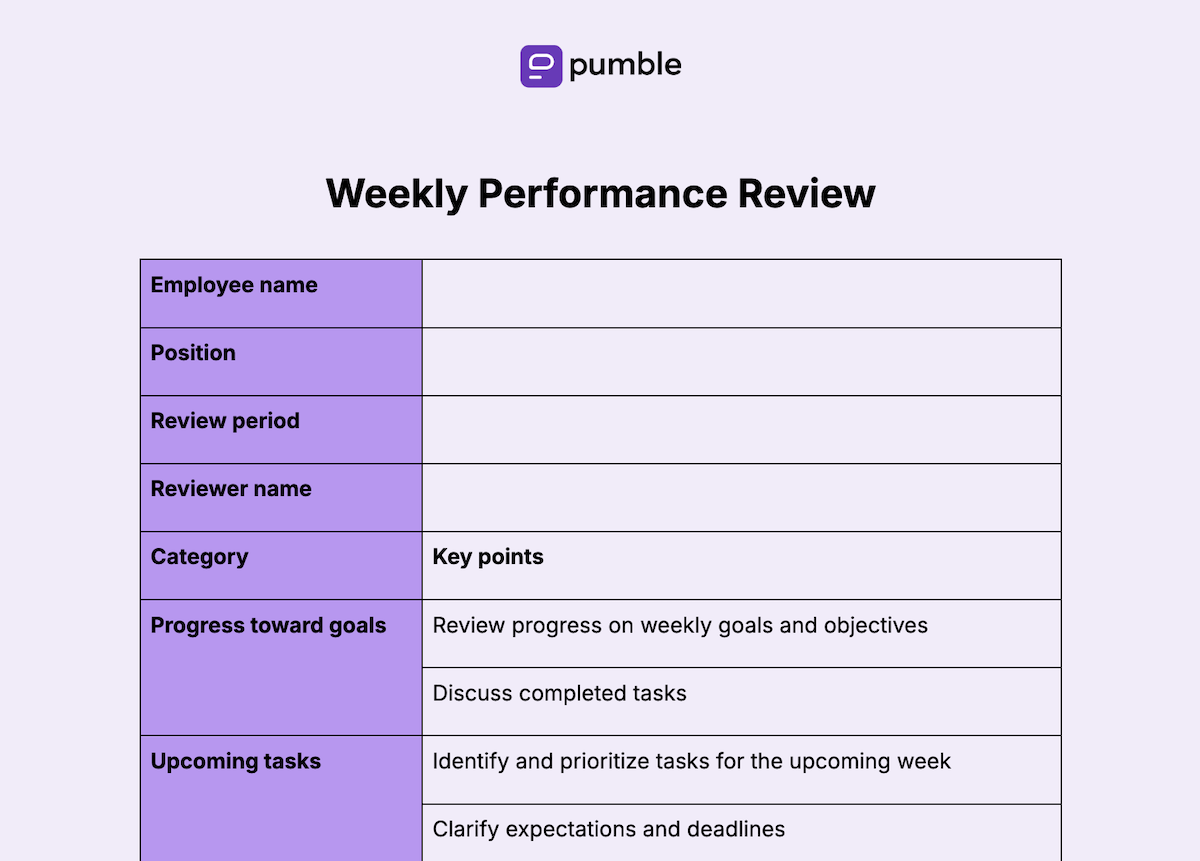
🔽 Download the Weekly performance review template
🔽 Download the printable Weekly performance review template
Simple performance review template
If you’re not interested in overly elaborating your employee evaluation, you can always conduct a simple performance review based on a numerical rating scale.
Our simple performance review template allows you to rate your employees on a scale of 1 to 5 across different categories, such as:
- Attendance,
- Punctuality,
- Productivity,
- Teamwork,
- Communication,
- Independence,
- Quality of work,
- Task prioritization,
- Initiative,
- Following policies, and
- Overall performance.
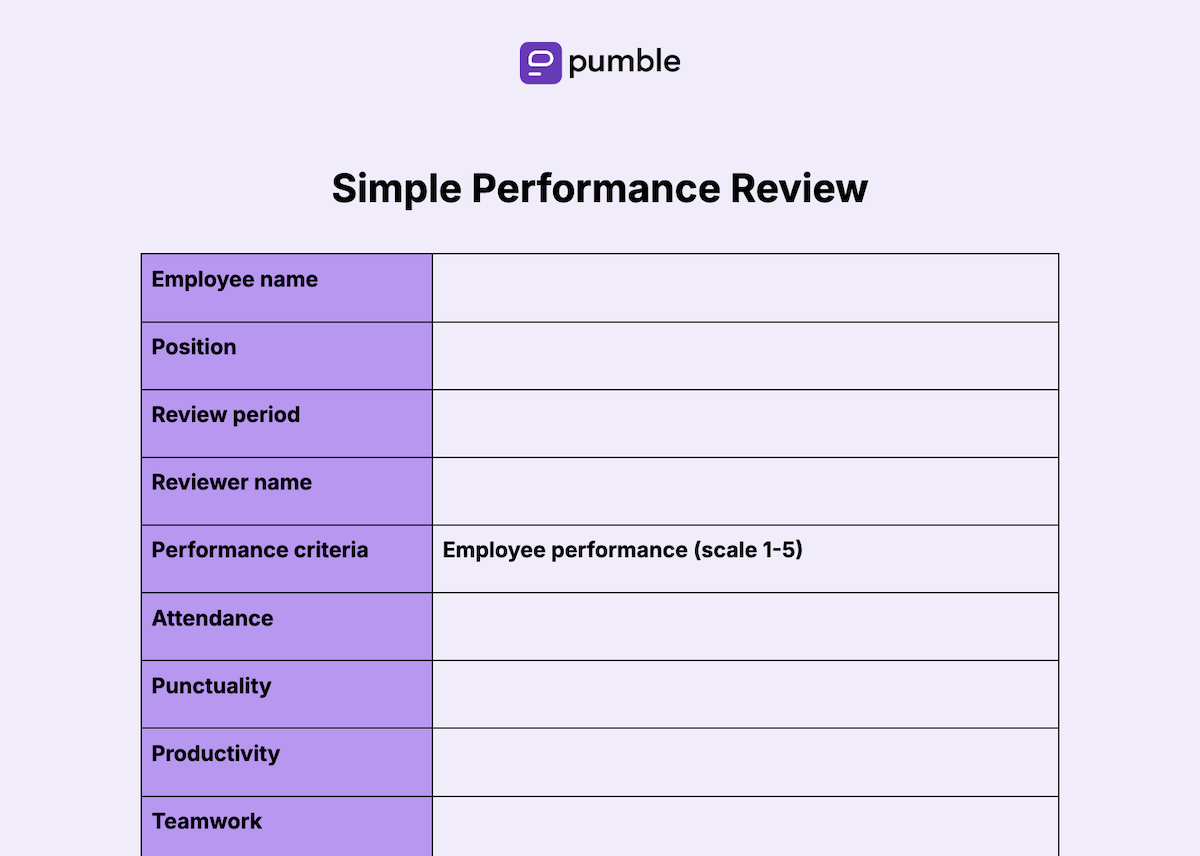
🔽 Download the Simple performance review template
🔽 Download the printable Simple performance review template
90-day performance review template
A 90-day performance review is usually held at the end of a 3-month onboarding period.
It focuses on the onboarding experience, organizational adjustments, and the application of skills and knowledge needed for the job.
Our 90-day performance review template includes sections that cover the following categories:
- Job knowledge,
- Performance,
- Organizational adjustment,
- Team collaboration,
- Company culture, and
- Overall performance.
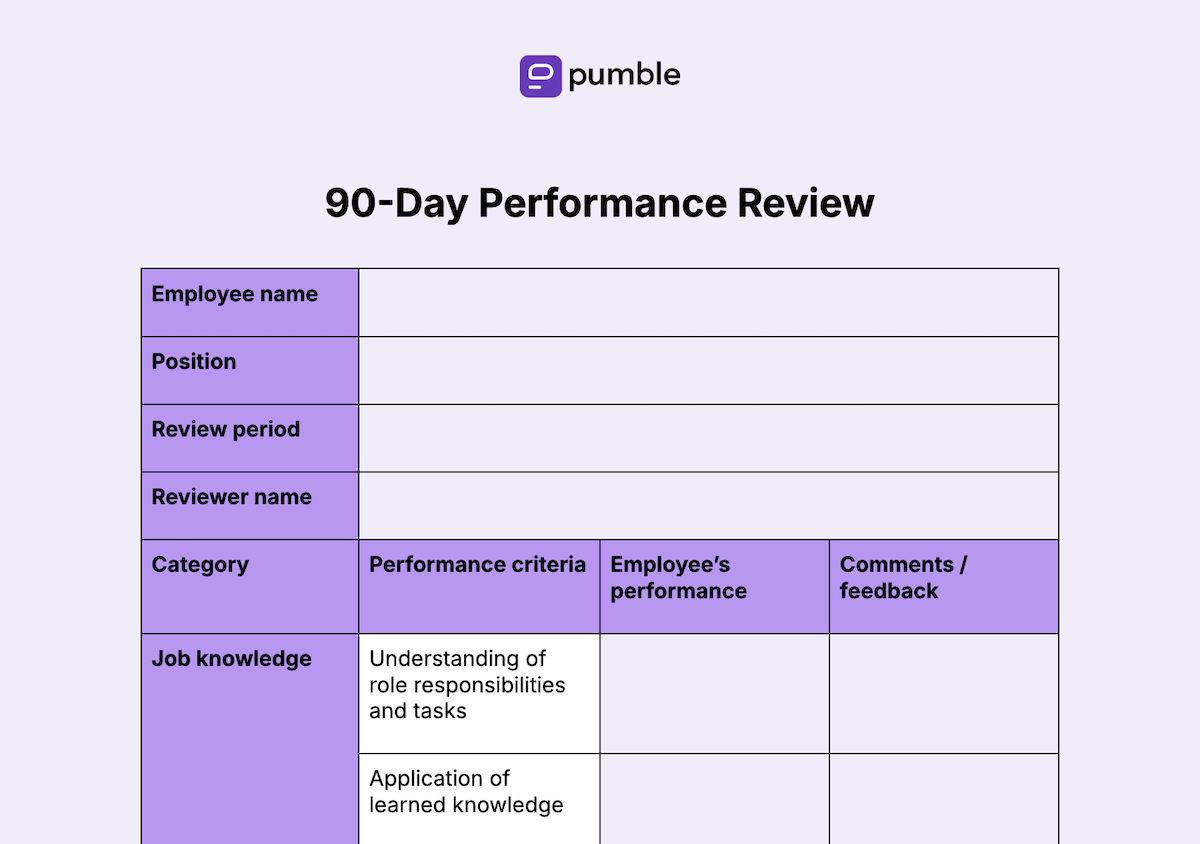
🔽 Download the 90-day performance review template
🔽 Download the printable 90-day performance review template
🎓 PUMBLE PRO TIP
Pumble is the perfect tool for keeping in touch with your employees throughout the onboarding process. Learn more about how you can use the app to your advantage here:
30-60-90 performance review template
A 30-60-90 performance review is another evaluation process companies might use while onboarding new employees.
As the name suggests, this evaluation process relies on check-ins held after the first 30, 60, and 90 days of a new hire’s employment. These reviews serve as checkpoints to assess progress, performance, and integration into the organization.
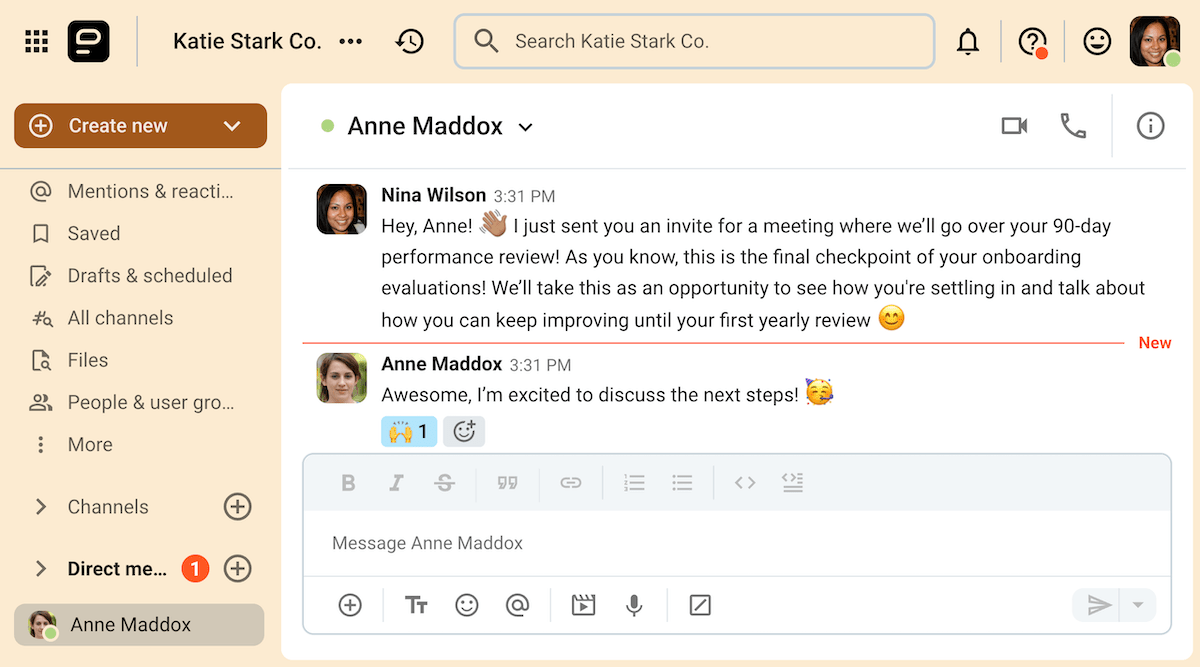
The 30-60-90 performance assessment benefits both the employee and the organization by allowing them to get to know each other’s needs and expectations and provide relevant feedback early on in the onboarding process.
With our 30-60-90 performance review template, you can write down your assessments for all 3 periods in one place. The categories we’ve included in our employee review template are:
- Job knowledge,
- Quality of work,
- Communication skills,
- Integration,
- Teamwork,
- Adaptability, and
- Overall performance.
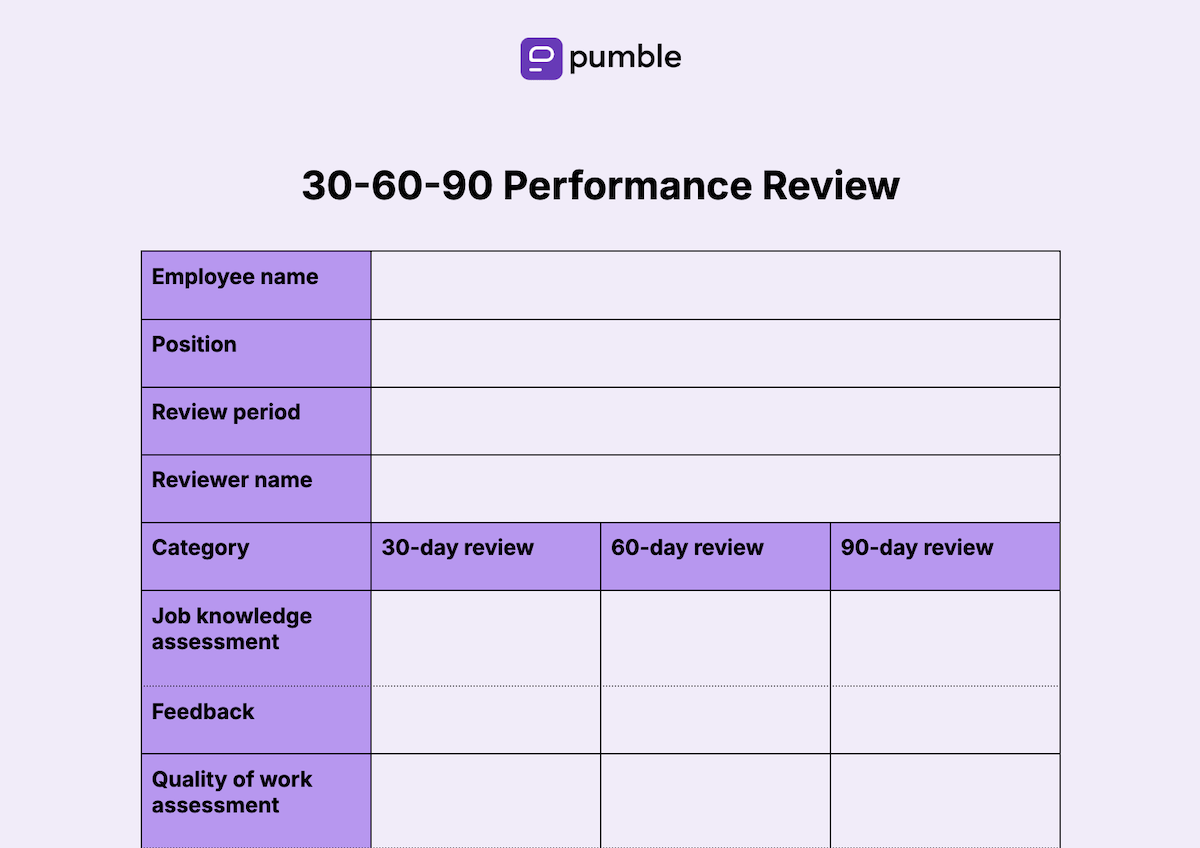
🔽 Download the 30-60-90 Performance review template
🔽 Download the printable 30-60-90 Performance review template
360 performance review template
A 360 performance review is a comprehensive evaluation process that gathers meaningful feedback about an employee from multiple sources.
For example, an employee’s performance may be evaluated not only by their direct supervisor but also by their peers, direct reports, higher management, and even external individuals such as clients and customers.
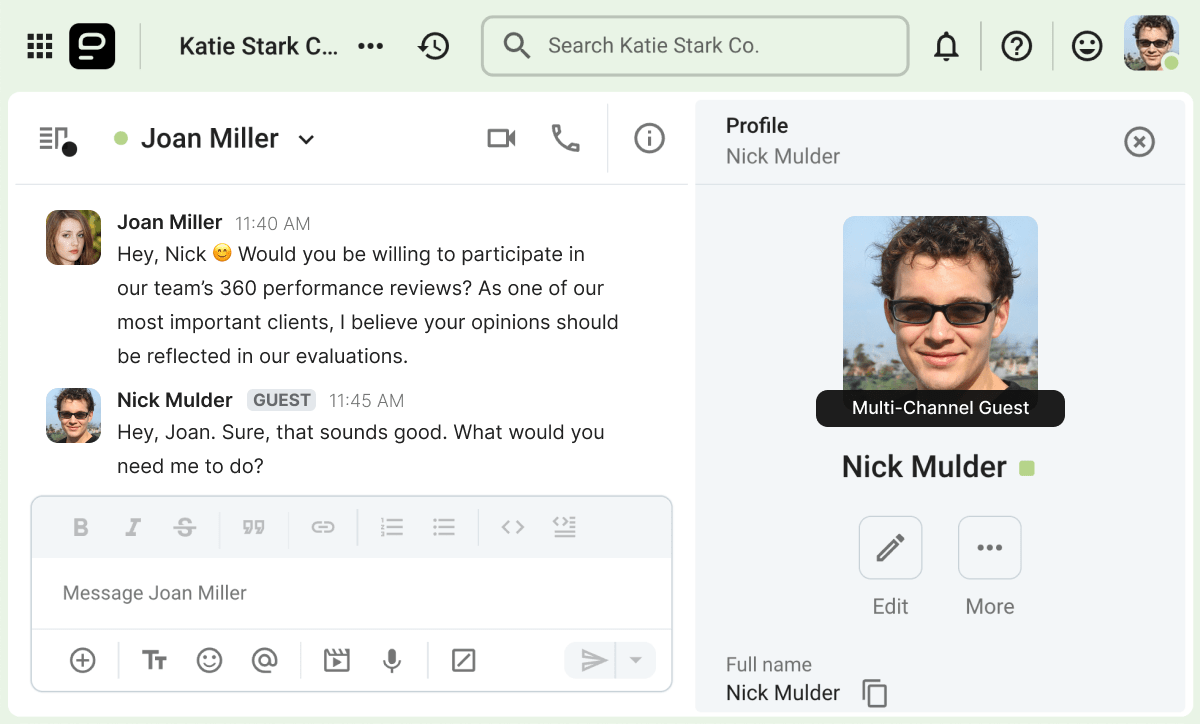
Conducting a 360 performance review can be challenging due to the varied nature of feedback collected from multiple sources. Even so, you can use a suitable performance review template from this list to collect feedback from the people who can evaluate your employees’:
- Job knowledge,
- Communication skills,
- Team collaboration,
- Problem solving,
- Leadership qualities,
- Adaptability,
- Quality of work, and
- Overall performance.
Once you have those review forms back, you can use our 360 performance review template to create a summary based on 3 different sources, as seen below.
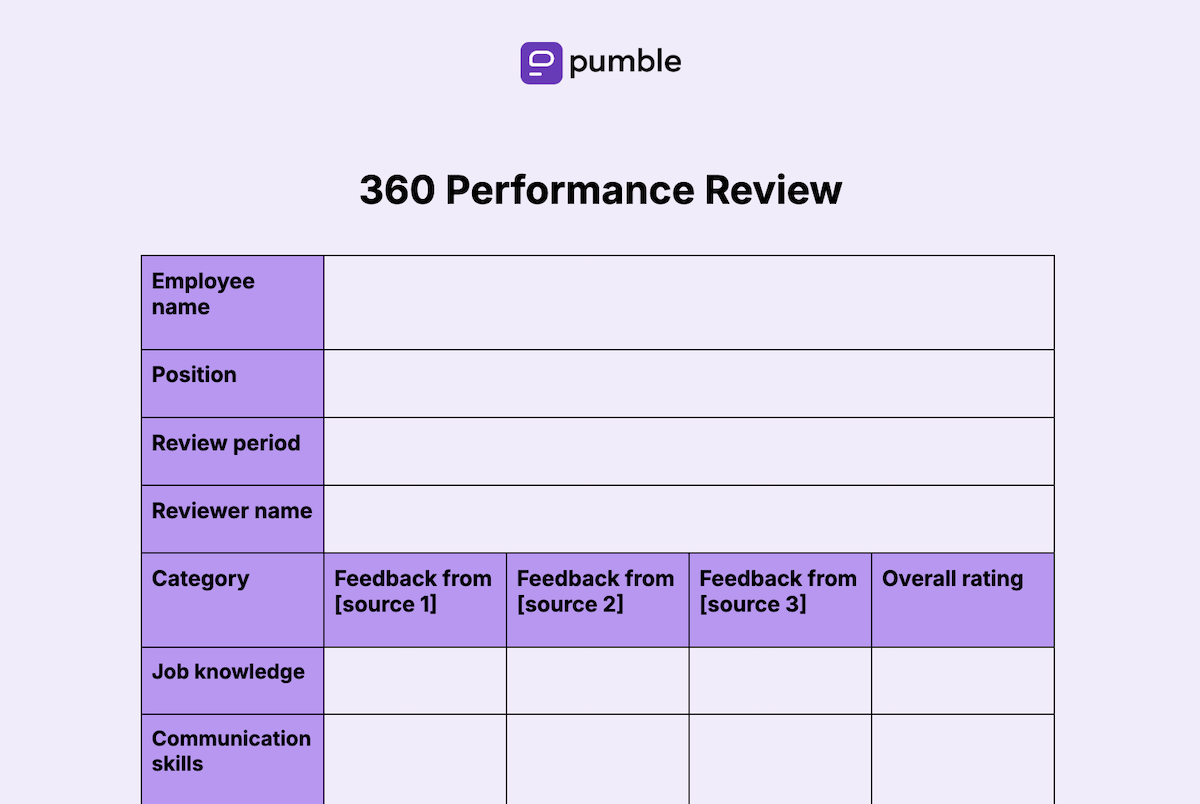
🔽 Download the 360 Performance review template
🔽 Download the printable 360 performance review template
🎓 PUMBLE PRO TIP
Throughout the review period, you may find yourself attending meetings with higher management without the presence of your direct supervisors. These meetings are called skip-level meetings, and you can learn more about them here:
Team performance review template
A team performance review assesses a team’s collective performance, achievements, and challenges.
As such, team performance reviews evaluate the overall performance and dynamics of a group of individuals working together, with a special focus on how they collaborate to achieve common goals.
Team performance reviews may be held periodically (e.g., quarterly or annually) or in response to specific events or projects. You can conduct them through:
- Structured meetings,
- Surveys, or
- Individual assessments of team members, which contribute to a larger picture.
You can use our team performance review template to assess and comment on your teams’ performance across various categories, including:
- Goal alignment,
- Communication,
- Collaboration,
- Problem solving,
- Decision making,
- Accountability,
- Productivity,
- Task delegation,
- Innovation,
- Adaptability,
- Leadership,
- Team and employee morale, and
- Overall performance.
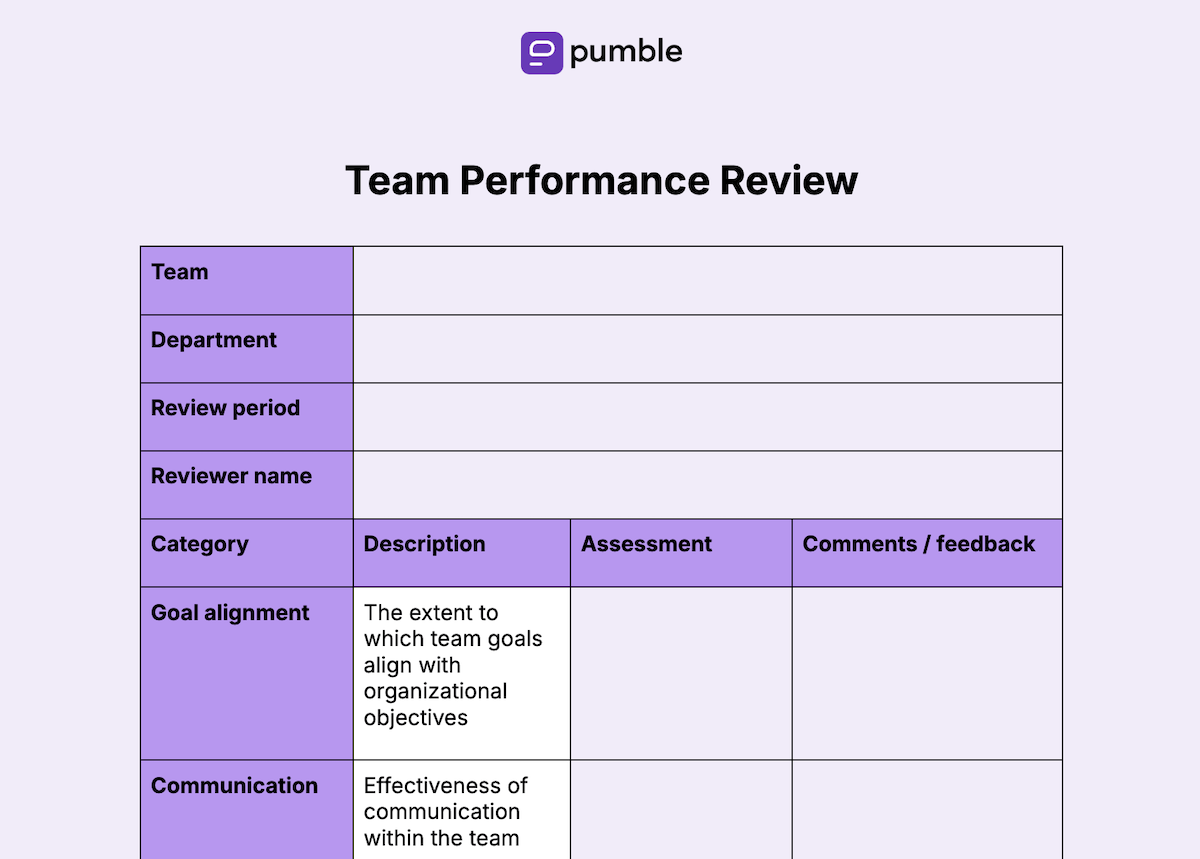
🔽 Download the Team performance review template
🔽 Download the printable Team performance review template
🎓 PUMBLE PRO TIP
To learn more about how to measure team collaboration and performance, follow our guide:
Employee self-evaluation performance review template
Employee self-evaluation is usually conducted alongside a formal performance review by the employee’s manager or supervisor.
The purpose of a self-evaluation is to encourage employees to:
- Reflect on their performance,
- Learn from past challenges, and
- Be prepared to meaningfully contribute during the performance review meeting later on.
Our performance review template can help your employees consider their performance in the following categories:
- Job knowledge,
- Communication skills,
- Team collaboration,
- Problem solving,
- Adaptability,
- Leadership,
- Quality of work, and
- Overall performance.
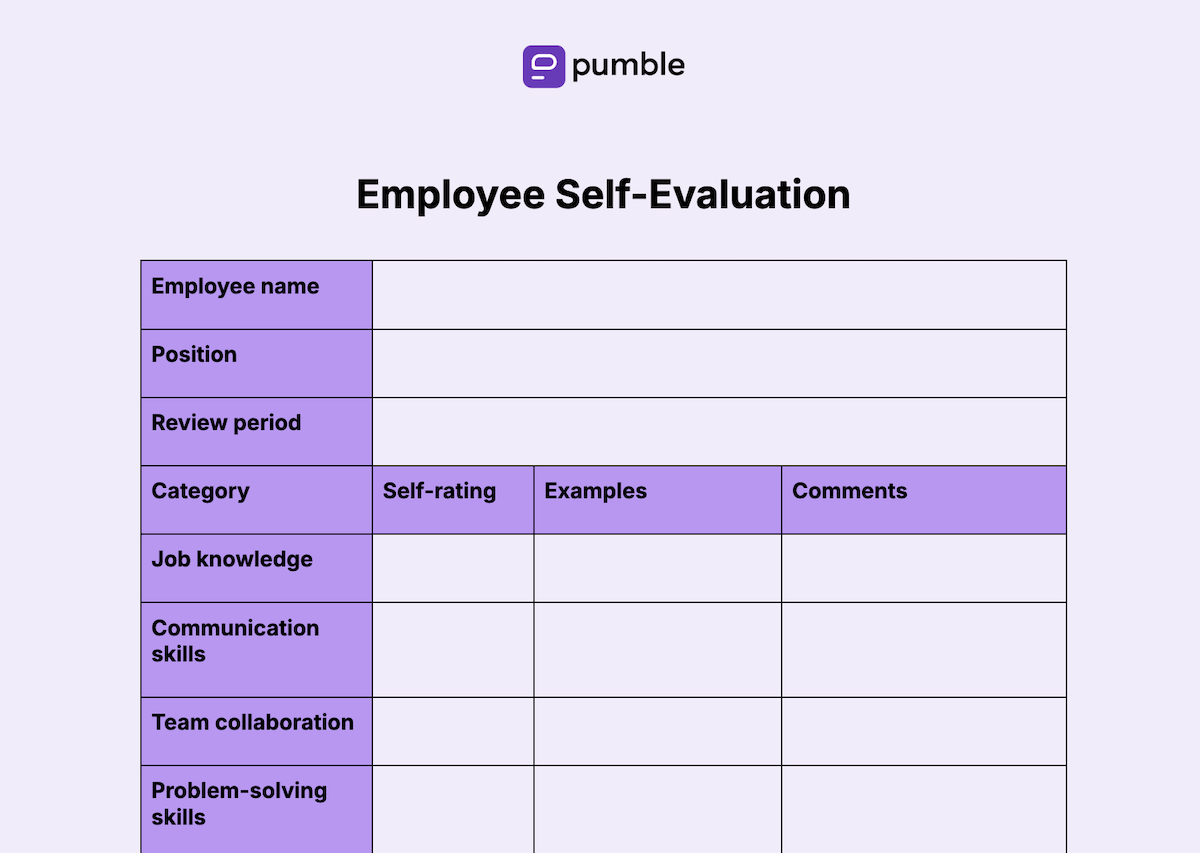
🔽 Download the Employee self-evaluation template
🔽 Download the printable Employee self-evaluation template
🎓 PUMBLE PRO TIP
At the end of a performance review period, employees who exceed expectations can use the opportunity to request higher salaries and better benefits. But, to do so effectively, they need to know how to advocate for themselves at work. Here’s a guide that can help you and your team members do just that:
Professional development review template
A professional development review is designed to evaluate an individual’s skill development and growth and the potential in their professional development journey.
Unlike traditional performance reviews, which primarily focus on past performance, professional development reviews can help employees identify areas for growth, skill development, and career advancement.

Support your team’s development with Pumble
Professional development reviews can be conducted periodically (e.g., annually or biannually) or in conjunction with annual performance reviews.
We’ve prepared a professional development review template you can use to assess an employee’s potential for growth and development with the help of the following criteria:
- Career goals,
- Strengths,
- Areas for improvement,
- Skill development,
- Training needs,
- Professional networking,
- Mentorship/coaching,
- Career progression,
- Work-life boundaries, and
- Development plan.
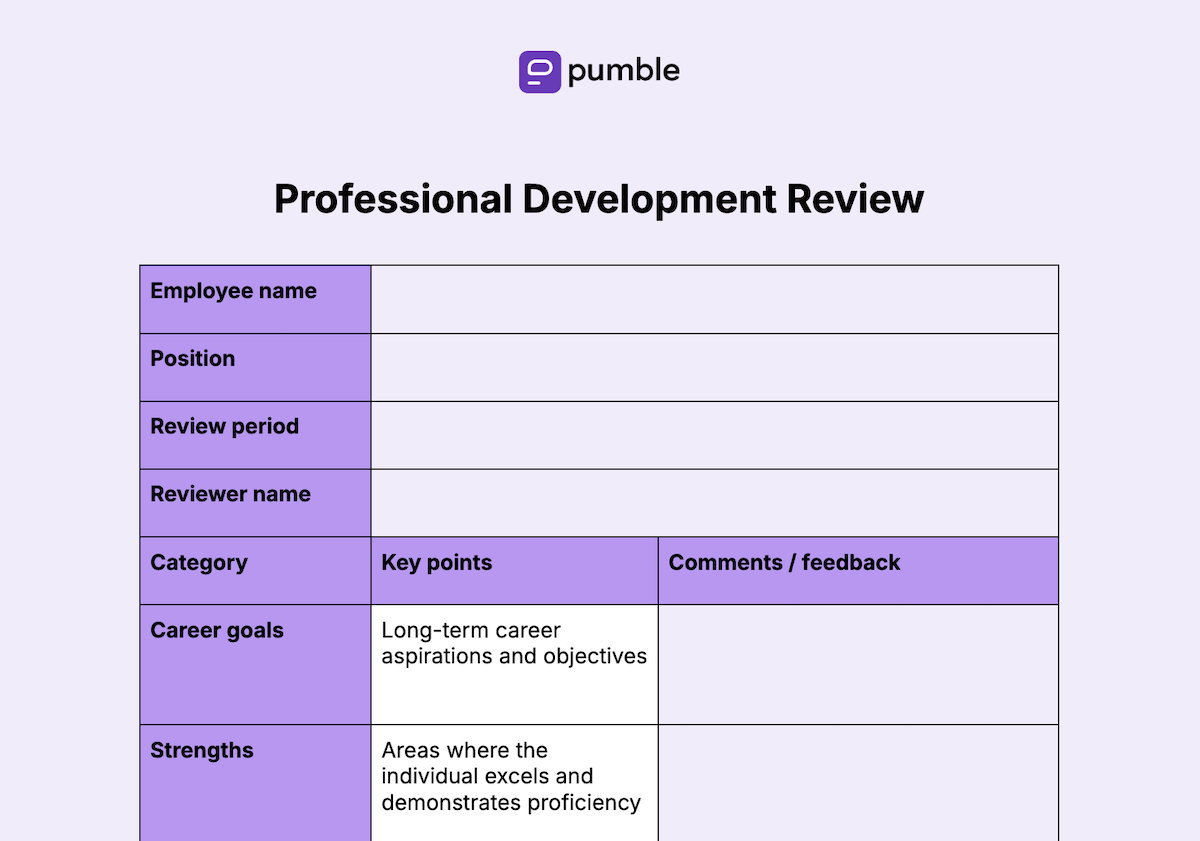
🔽 Download the Professional development review template
🔽 Download the printable Professional development review template
🎓 PUMBLE PRO TIP
A professional development review is an excellent chance to talk about promotions. To find out more about how and when to ask your boss for a promotion, read our blog post:
Compensation review template
A compensation review is an evaluation of compensation and benefits provided to employees.
It typically involves analyzing information such as market trends, employee performance, and organizational budget to determine the appropriate:
- Salary,
- Bonuses,
- Benefits,
- Incentives, and
- Other forms of compensation.
Transparency and effective communication with employees about the rationale behind compensation decisions are essential to maintaining employee satisfaction and trust.
Our compensation review template can help you make an informed decision about your employee’s salary and benefits by compiling information about:
- Market trends,
- Employee performance,
- Cost of living adjustment,
- Organizational budget,
- Equity and fairness,
- Career development,
- Current compensation assessment,
- Current benefits assessment,
- Other factors (e.g., special skills, certifications), and
- Future plans and actions.
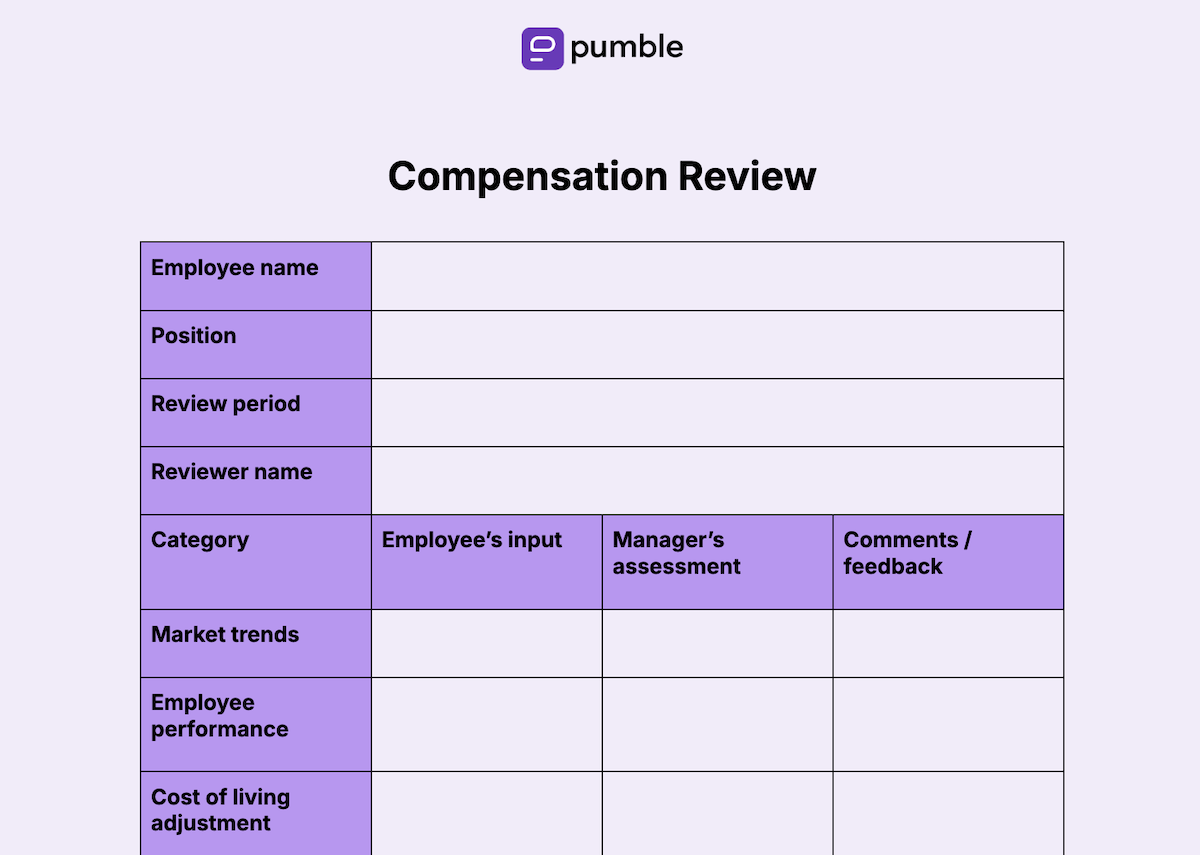
🔽 Download the Compensation review template
🔽 Download the printable Compensation review template
🎓 PUMBLE PRO TIP
Transparent communication is crucial for building trust in teams. To find out more about how to build trust in virtual teams, read our blog post:
Benefits of using a performance review template
Even though employee evaluations can be stressful for everyone involved, performance review templates can help make your next review period more bearable.
For one, templates ensure consistency, providing a structured framework and standardized format for all reviews. This consistency means that every employee is treated equally and evaluated against the same criteria.
Secondly, using an employee review template can help managers focus solely on accurately evaluating their employees’ performance.
Instead of having to create review questions from scratch, managers and HR employees can simply adjust a performance review template to make it more suitable for their organization, allowing them to focus on:
- Identifying areas for development,
- Providing meaningful feedback, and
- Setting goals.
A set template with concrete and relevant parameters will produce thorough and meaningful evaluations, ultimately benefiting both the employees and the organization.
Basically, performance review templates keep the evaluation process efficient and straightforward.
With predefined sections and prompts, managers can focus on relevant aspects of performance without getting bogged down in unnecessary details. This makes reviews comprehensive yet concise and allows for a clear understanding of expectations and areas of improvement.
What to write in a performance review
To make performance reviews relevant and accurate, it’s important to provide a balanced assessment of the employee’s performance. According to Aleksandra Babic, an HR Generalist at CAKE.com, an accurate and helpful performance review needs to be comprehensive:

“It’s important to evaluate an employee’s performance from different perspectives. Don’t just focus on areas that need improvement; make sure to also include their accomplishments and examples of great performance.”
With that in mind, here’s what you should include in your review to make it balanced:
- Performance evaluation — Assess the employee’s performance against specific criteria, such as job knowledge, quality of work, communication skills, teamwork, etc.
- Achievements — Highlight the employee’s relevant accomplishments and contributions in the review period.
- Areas for improvement — Identify areas where the employee can improve and illustrate them with examples through feedforward.
- Goal setting — Set S.M.A.R.T. goals for improvement in the future.
- Positive reinforcement — While providing constructive feedback, include positive reinforcement through empathic communication.
- Scaling system — For some criteria, you may be able to use a numerical rating system, but for others, you may need to be more descriptive. Don’t fall into the trap of having to put a number on everything.
Finally, as with every instance of professional communication, it’s essential to keep our reviews professional and polite, as Babic noted:

“Remember to remain objective, fair, and respectful when evaluating an employee’s performance and delivering the results. Even bad news can and should be delivered in a polite and professional manner.”
FAQ about performance reviews
After going through the whys and hows of performance reviews, you may have some additional questions.
We’ve answered some of the most frequently asked questions about performance reviews below.
What is the purpose of performance reviews?
The purpose of performance reviews is to assess and, later, optimize employee performance.
It’s an opportunity to:
- Provide feedback,
- Set goals for improvement, and
- Align expectations between the employee and the manager or organization as a whole.
How often should you review employee performance?
Even though performance reviews should be conducted regularly, figuring out how often you need to do them will be left to your company’s discretion.
Generally, the optimal frequency of evaluations can depend on the nature of your work, your organizational needs, and the industry standards.
Still, the most common intervals for performance reviews are:
- Annual,
- Semi-annual,
- Quarterly, or
- Monthly.
The goal is to provide timely feedback and support employee development, so you should time your reviews accordingly.
But, if you find that the evaluation schedule you’ve chosen doesn’t quite suit your company, you can always change it — as long as you communicate about those changes in a timely manner.
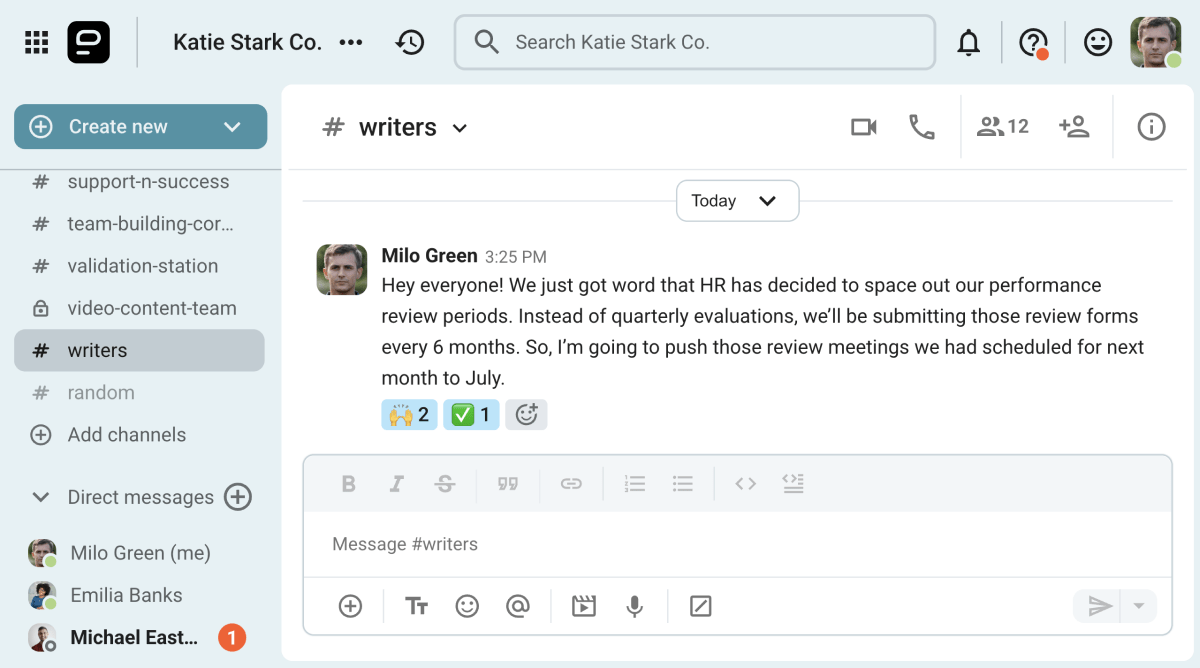
Use Pumble to seamlessly communicate change to your team
How can I prepare for a performance review as an employee?
As an employee, you can influence how your performance review pans out by taking ownership of your performance and professional development.
As it happens, being prepared for a performance review will also make your manager’s job easier.
So, if you want to cover all your bases, you can:
- Reflect on your performance and achievements,
- Think about the challenges you’ve faced,
- Identify areas of improvement as well as your strengths,
- Prepare examples and evidence of your claims, and
- Anticipate questions you may be asked to prepare relevant answers.
However, don’t let performance reviews stress you out.
Approach them with a positive attitude and aim to learn more about yourself and grow. Ultimately, employee evaluations allow you to learn how to accept constructive feedback and demonstrate your commitment to professional development.
At the end of the day, performance reviews evaluate your performance to help you become a better version of yourself — so, make the most of them.
How do I deliver bad performance review results as a manager?
As a manager, you should accept that not every team member will receive a positive employee evaluation.
That means that you’ll probably have to discuss team members’ less-than-ideal performance review results sooner or later.
Though no one looks forward to having those difficult conversations, you can make them less awkward for everyone involved. Before you go into that meeting, you should:
- Prepare thoroughly and gather specific examples and evidence to support your assessment.
- Start with positive feedback by acknowledging the employees’ strengths and contributions.
- Focus on behavior and avoid commenting on an employees’ personality or characteristics. Keep the feedback focused on their actions and performance.
- Be direct when communicating about how the employees’ performance is falling short. Use specific examples to illustrate your point.
- Encourage your employees by providing resources and support to help them address areas for improvement.
Above all, you should approach the conversation with sensitivity and professionalism and try to actively listen when the employee shares their point of view.
Babic provides another useful tip for handling a bad performance review result. Namely, she emphasizes the importance of choosing the right time and place to deliver bad news:

“Managers should pay attention to how and when they deliver bad news. Poor performance review results should only be discussed in a one-on-one meeting with the employee. You can celebrate wins and praise your employees in a group setting, but leave the negative feedback for a private conversation.”
Even when delivering bad performance review results, your focus should be on finding ways to help your team members achieve their potential.
What is a performance improvement plan?
A performance improvement plan (PIP) is a document outlining specific areas where employees’ performance fell below expectations.
This document also details the steps employees need to take to improve their work outcomes.
A performance improvement plan typically includes:
- Clear examples of poor performance,
- Measurable goals and objectives for improvement,
- Timelines for achieving these goals,
- Resources needed to improve performance, and
- Consequences if performance is not improved within the specified time.
Performance improvement plans are usually implemented after a poor performance review. However, they are typically based on the severity and persistence of performance issues and are also highly dependent on the industry and internal policies and procedures of the organization.
🎓 PUMBLE PRO TIP
Before employees are placed on a performance improvement plan, they usually receive written communication stating that their performance has been found lacking. To learn more about these official write-ups, check out this article:
Hold your performance reviews via Pumble
Conducting performance reviews can be emotionally and physically exhausting.
You need to juggle finding relevant information, thinking about your employee’s feelings, and ultimately deciding on the best course of action for their professional development. Add to that the other tasks of your job, and you can burn out.
But, don’t let your tech be another point of stress during your next review period.
With Pumble, you can hold performance review meetings without a hassle.
Pumble is a team collaboration software that lets you communicate with team members via:
- Direct messages,
- Channels, groups, and threads,
- Video and voice calls, and
- Video and voice messages.
Use direct messages to set up individual meetings with your employees and hop on a one-on-one video call to discuss the results of their performance reviews.

After the call, you can make the most of the app’s storage capacity (and foster transparent communication) by sharing relevant documents with your team.
With an intuitive interface and many customization options, Pumble can help you hold effective and productive performance reviews.
How we reviewed this post: Our writers & editors monitor the posts and update them when new information becomes available, to keep them fresh and relevant.


